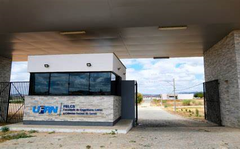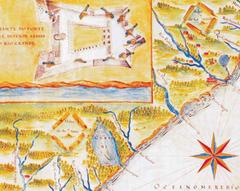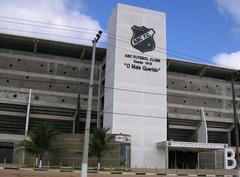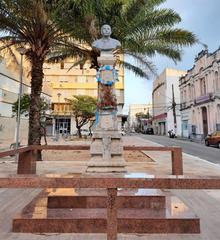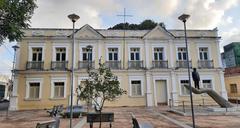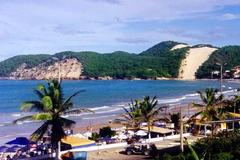Our Lady of the Presentation Cathedral, Natal, Brazil: Visiting Hours, Tickets, and Historical Sites Guide
Date: 04/07/2025
Introduction
Nestled in the historic Cidade Alta district of Natal, Brazil, the Our Lady of the Presentation Cathedral (Catedral Metropolitana de Nossa Senhora da Apresentação) is a powerful symbol of faith, culture, and innovative architecture. Rooted in Natal’s colonial origins—founded on Christmas Day in 1599—the cathedral is dedicated to the city’s patroness, Our Lady of the Presentation. Her feast day on November 21 unites thousands of faithful in vibrant religious and civic celebrations. The cathedral is not only the spiritual heart of the Archdiocese of Natal but also a testament to the community’s resilience and devotion, representing centuries of ecclesiastical development and cultural engagement (arquidiocesedenatal.org.br, audiala.com).
The current cathedral, inaugurated in 1988 after construction began in 1973, departs from Brazil’s traditional colonial and Baroque church designs. Its modernist, trapezoidal plan, soaring concrete forms, and expansive open nave create an uplifting environment for reflection and worship. The innovative use of natural light, minimalist art, and symbolic upward lines evoke a spiritual journey while honoring local culture (GCatholic, Architecture Adrenaline).
This comprehensive guide covers essential visiting details—hours, tickets, and accessibility—alongside the cathedral’s rich history, architectural highlights, cultural significance, and practical travel tips. Whether you are a pilgrim, history enthusiast, or traveler, exploring Our Lady of the Presentation Cathedral promises a meaningful and inspiring experience.
Table of Contents
- Early Foundations and Colonial Context
- The First Cathedral and Its Legacy
- Planning and Construction of the Modern Cathedral
- Religious and Cultural Significance
- Architectural Features and Innovations
- Visiting Hours, Tickets, and Accessibility
- Nearby Attractions and Travel Tips
- Frequently Asked Questions (FAQs)
- Preservation and Continuing Legacy
- Community and Cultural Engagement
- Practical Visitor Tips
Early Foundations and Colonial Context
Natal’s foundation in 1599 coincided with the expansion of Portuguese colonialism in Brazil. The city’s name—meaning “Nativity” in Portuguese—reflects its Christmas Day origin (natalriograndedonorte.com). The Catholic Church played a central role from the outset, with Jesuit missionaries evangelizing the indigenous Potiguara people and establishing the city’s first parish, dedicated to Our Lady of the Presentation. The construction of Forte dos Reis Magos in 1598 solidified the city’s strategic importance and Catholic identity (arquidiocesedenatal.org.br).
The First Cathedral and Its Legacy
Efforts to build a cathedral began in the 19th century under Father João Maria Cavalcanti de Brito. Despite local devotion and collective efforts, the original project was left incomplete, with only its columns serving as a reminder of the community’s aspirations (arquidiocesedenatal.org.br). The Igreja Matriz de Nossa Senhora da Apresentação, located in Praça André de Albuquerque, became the main church. As Natal grew, the need for a larger, more modern cathedral became apparent.
Planning and Construction of the Modern Cathedral
Under Archbishop Dom Marcolino Esmeraldo de Souza Dantas, plans for a new cathedral gained momentum. Initial designs were revised in favor of a modernist structure capable of seating 3,000 worshippers. The project, led by architect Marconi Grevi and engineer José Pereira da Silva, emphasized liturgical functionality, inclusivity, and spiritual elevation. After extensive community fundraising and nearly 18 years of construction, the cathedral was inaugurated on November 21, 1988 (arquidiocesedenatal.org.br).
Religious and Cultural Significance
The cathedral’s dedication to Our Lady of the Presentation carries deep meaning for Natal’s Catholics. The annual feast day, celebrated on November 21, is a major religious and civic event featuring processions, Masses, and cultural festivities (arquidiocesedenatal.org.br). As the seat of the Archdiocese, the cathedral is pivotal in promoting religious life, social outreach, and education throughout the region.
Architectural Features and Innovations
Distinctive for its bold modernist style, the cathedral’s trapezoidal floor plan, soaring concrete forms, and open nave reflect late 20th-century ecclesiastical trends (GCatholic, Architecture Adrenaline). Large glass panels admit abundant natural light, symbolizing divine presence and creating a contemplative atmosphere. The minimalist altar, circular presbytery, and lack of interior columns foster a sense of community and unity during worship.
The interior is adorned with contemporary religious art—stained glass windows, sculptures, and reliefs that blend biblical themes with regional Catholic traditions. The crypt beneath the sanctuary houses the remains of several bishops. The Pío X Pastoral Center, located under the nave, contains administrative offices and pastoral coordination spaces (Wikipedia).
Visiting Hours, Tickets, and Accessibility
- Visiting Hours: Monday to Saturday, 7:00 AM – 7:00 PM; Sundays, 7:00 AM – 1:00 PM (hours may vary on holidays and feast days).
- Entry: Free of charge. Donations support maintenance and charitable programs.
- Guided Tours: Available in Portuguese and English by prior arrangement, offering deeper insights into the cathedral’s art, architecture, and history (audiala.com).
- Accessibility: Ramps and accessible restrooms are provided. The spacious nave accommodates wheelchairs and strollers.
- Dress Code: Modest attire is expected—shoulders and knees covered; hats removed in the sanctuary.
- Photography: Permitted except during services; refrain from using flash and be discreet during ceremonies.
Nearby Attractions and Travel Tips
The cathedral is centrally located at Praça Sete de Setembro in Cidade Alta, making it an ideal starting point for exploring Natal’s historic sites. Notable nearby attractions include:
- Forte dos Reis Magos: A 16th-century star-shaped fort offering panoramic views and insights into colonial history.
- Praça André de Albuquerque: Site of the original cathedral and a vibrant community square.
- Alberto Maranhão Theater: A stunning example of Belle Époque architecture.
- Natal Historic Center: Rich in colonial architecture, restaurants, and shops (Inner Brazil).
Travel Tips:
- Use public transport or taxis due to limited parking.
- Weekday mornings are quieter for photography; festivals and feast days provide a lively cultural experience.
- Services and signage are mainly in Portuguese, but some staff speak English or Spanish.
Frequently Asked Questions (FAQs)
Q: What are the cathedral’s visiting hours?
A: Monday to Saturday, 7:00 AM – 7:00 PM; Sunday, 7:00 AM – 1:00 PM.
Q: Is there an admission fee?
A: Entry is free; donations are appreciated.
Q: Are guided tours available?
A: Yes, in Portuguese and English by prior arrangement.
Q: Is the cathedral accessible for people with disabilities?
A: Yes, with ramps and accessible restrooms.
Q: Can I take photographs inside?
A: Yes, except during services; be respectful and avoid flash.
Preservation and Continuing Legacy
The cathedral is a testament to the faith and creativity of Natal’s people. Its construction was a collective effort, and it continues to adapt to community needs while preserving its sacred mission. As a center for worship, cultural events, and social outreach, it remains a living monument to Catholicism in northeastern Brazil (arquidiocesedenatal.org.br).
Community and Cultural Engagement
Religious Festivals and Community Gatherings
The cathedral is the focal point for Natal’s most significant religious and cultural festivals, especially the annual feast of Our Lady of the Presentation, which includes processions, special Masses, and city-wide celebrations (tieronetravel.com). Other major Christian holidays, such as Christmas and Easter, are marked by elaborate liturgies and communal meals.
Social Outreach and Education
The cathedral partners with local schools and community organizations to support education, food drives, and health initiatives (olplsecc.org). Programs foster values of peace, justice, and service among youth and families.
Cultural Events and Artistic Expression
Concerts, art exhibitions, and lectures are regularly hosted at the cathedral, celebrating regional heritage and traditional music such as forró. Food stalls during festivals offer local specialties like “ginga com tapioca” (audiala.com).
Practical Visitor Tips
- Timing: Visit during weekday mornings for quiet reflection or during festivals for a vibrant cultural experience.
- Engagement: Attend Mass or a special event to experience local faith and community.
- Combine Visits: Pair your cathedral visit with other historic sites in Cidade Alta.
- Language: Learn basic Portuguese phrases for a more engaging experience.
- Safety: The area is well-patrolled, but remain vigilant with belongings, especially at night.
Summary and Call to Action
Our Lady of the Presentation Cathedral is a vital destination for anyone exploring Natal’s spiritual heritage and architectural innovation. From its colonial roots to its role in contemporary cultural life, the cathedral embodies the enduring faith and community spirit of the city. Plan your visit by checking official hours, arranging guided tours, and using resources like the Audiala app for the best experience.
Explore more about Natal’s historical and cultural sites by downloading the Audiala app and following our updates on social media. Make your visit to the cathedral a memorable journey into the heart of northeastern Brazil’s spiritual and cultural legacy.
References
- History of the Archdiocese of Natal – arquidiocesedenatal.org.br
- Catedral Metropolitana de Natal Visitor Information – arquidiocesedenatal.org.br
- GCatholic: Our Lady of the Presentation Cathedral
- Architecture Adrenaline: Religion’s Influence on Architecture
- Inner Brazil: 20 Fun Things to Do in Natal
- Audiala: Guide to Natal
- Tier One Travel: Must-See Brazil Festivals
- Wikipedia: Our Lady of the Presentation Cathedral, Natal
- OLPLSECC Community Engagement

